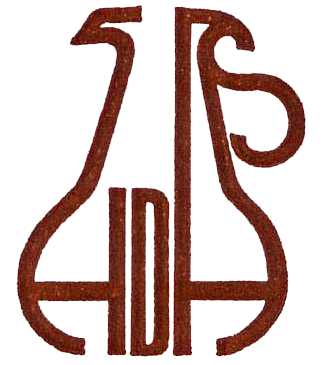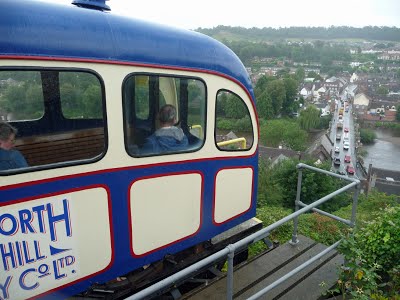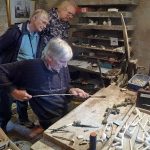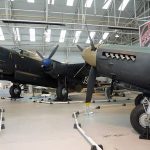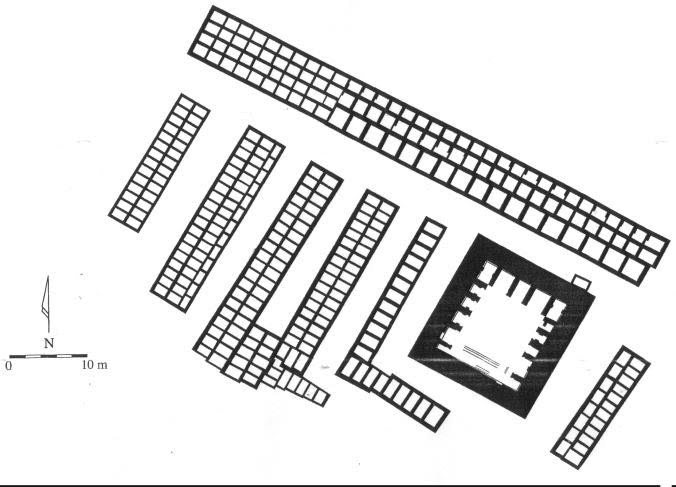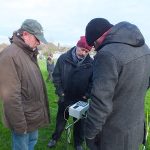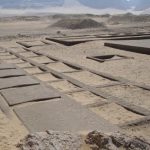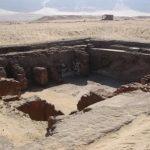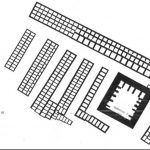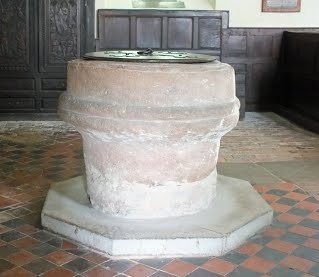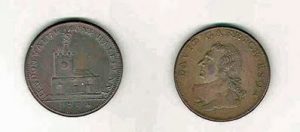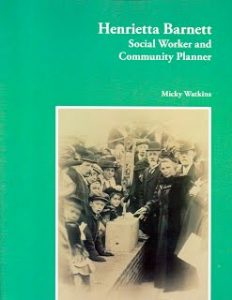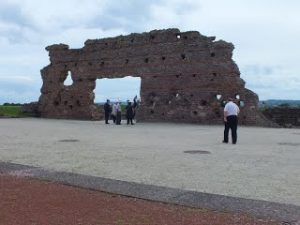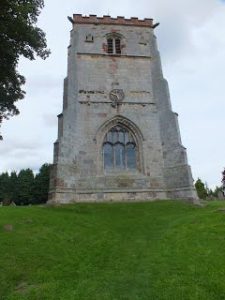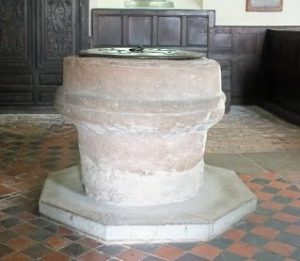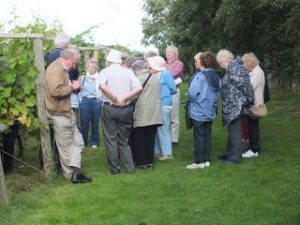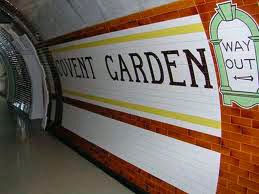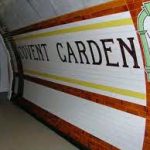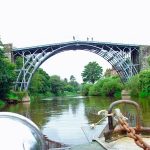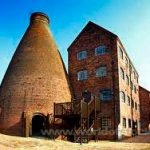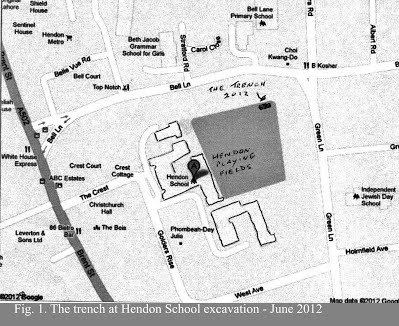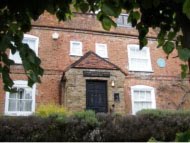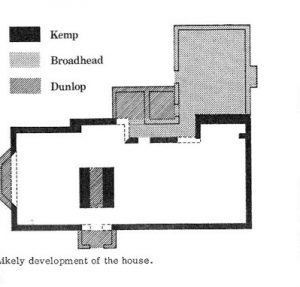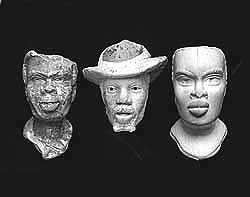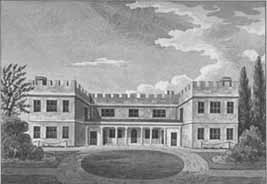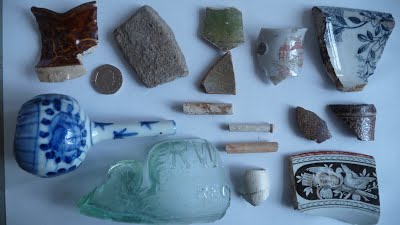No. 500 November 2012 Edited by Jim Nelhams
Editorial
Newsletter 500: another milestone in our history. Our monthly newsletters are one of the benefits of membership of our group. Although HADAS was founded in 1961, the first newsletter did not appear until October 1969. Through the early years, publication was occasional, so only now have we reached our 500. It’s still a chance to dig up some of our past, while including reports on recent activity. As usual, we start, as we should, by looking forward.
HADAS DIARY 2012 – 2013
All Lectures are held at Avenue House, 17 East End Road, Finchley, N3 3QE, and start promptly at 8.00 pm,
with coffee /tea and biscuits afterwards. Non-members welcome (£1.00). Buses 82, 125, 143, 326 & 460 pass nearby and Finchley Central Station (Northern line) is a short walk away.
Tuesday 13 November: Archaeological Discoveries in Southwark. Lecture by Peter Moore, Pre- Construct Archaeology (PCA).
Peter has been working in archaeology for 32 years and in the commercial archaeological sector for the last 25, as a site supervisor for 3 years and as a project manager for 21 years. Before join- ing PCA in 1995 he concentrated on managing projects in northeast London and southwest Essex, and since then he has been responsible for undertaking projects across southeast England and on a national basis. He has been a director of PCA since 1998. He writes –
“The lecture I will give will consist of the recent findings PCA have made around Bermondsey Square (Roman, Saxon and Medieval) and Elephant & Castle (which will be ongoing – Medieval to 19th century graveyard) and that PCA have made together with the Oxford Unit on the Thameslink projects at Borough Market, Borough High Street and London Bridge (Roman to Post-Medieval).”
Sunday 2 December: Christmas Party at Avenue House, 12 noon – 4.30 pm (approx.) A buffet lunch. Price £22 to include some drink. Your chance to meet or catch up with friends and colleagues. A booking form is with this newsletter. Please return this by 15th November as we need to book the right amount of food and drink.
Tuesday 8 January: The Reign of Akhenaten: Revolution or Evolution? Lecture by Lucia Gahlin (who has kindly stepped in to replace Nathalie Andrews).
Tuesday 12 February: From Longboat to Warrior: the evolution of the wooden ship. Lecture by Eliott Wragg, Thames Discovery Programme.
Tuesday 12 March: The Railway Heritage Trust – Lecture by Andy Savage.
Tuesday 9 April: Nautical Archaeology – past, present and future. Lecture by Mark Beattie-Edwards, Programme Director, Nautical Archaeology Society.
Future Outings
We are looking at possible hotels in the Buxton area for our long outing next year. More information
when available. The new Mary Rose Museum in Portsmouth was due to open this November, but the date has now changed to “early in 2013”. It certainly should be open next summer, so we plan a visit to the Portsmouth Historic Dockyard at some stage.
Extracts from our Old Newsletters
From Newsletter 100 (June 1979)
The first news was that although we now have a small room at Avenue House where we keep books and records and 3 or 4 people can work, we are still without, and still desperately need, a real head- quarters. If any member can suggest how HADAS might obtain the use of a large room, with some means of lighting and warmth, available at weekends as well as during the week, will they please, without hesitation, let any member of the Committee know about it? The room needs to be big enough to take 20/25 members at a processing session; and HADAS would have to be the sole occupant, so that the room could be locked when not in use and work in progress left undisturbed.
(Perhaps at Church Farmhouse… Ed.)
From Newsletter 200 (October 1987): A Greater Architect than Wren?
Some authorities claim he was, but Henry Yevely, master mason, is a name of little popular recognition. HADAS member Ann Saunders is aiming to end some of that neglect, with an exhibition on Yeveley at the Church of St Magnus-the-Martyr, Lower Thames Street beside London Bridge, from October 12-18.
Henry Yeveley, writes Dr Saunders, was responsible for raising the walls of Westminster Hall to support the magnificent hammerbeam roof, for continuing the nave of Westminster Abbey, for work on Canterbury Cathedral and at the Tower of London, and for much else besides. The exhibition attempts to illustrate his more important achievements and to give some idea of the religious and social life of the 14th century.
Events associated with the exhibition are an illustrated talk of The Dress of Working Londoners in the Time of Henry Yeveley, by Helen McCarthy (October 13, 1.05pm) followed by a short recital of medieval music; a slide lecture on Yeveley by John Harvey (October 14, 7pm); readings from Chaucer’s Canterbury Tales (October 15, 12.50pm); a lecture for schools on medieval London by Dr Saunders (October 15, 2.30pm). All are in the church.
From Newsletter 300 (March 1996)
Percy Reboul, another long-standing member, is reported in an extract from a Plastics Industry Journal: The Greater London Industrial Archaeological Society (GLIAS) heard an entertaining history of “The Material with a Thousand Uses”. The history of Bakelite was presented by Percy Reboul, who is Chairman of the Plastics Historical Society. The golden age of Bakelite radios and telephones has now passed, bringing the closure of the 26-acre Tyseley plant in Birmingham, operated by BXL for whom Percy worked. The thrust of the lecture, which stimulated considerable interest among the GLIAS members, was firmly in the past. Percy’s gift for bringing this to life and his unfailing enthusiasm for
the subject were clearly on display. (Percy gave the same lecture to the Finchley Society on 29 February.)
From Newsletter 400 (July 2004): Congratulations to Dorothy by Denis Ross
Congratulations to our Vice-President Dorothy Newbury, who has been awarded an MBE for services to Archaeology in North London. This is a very well-deserved honour as Dorothy has devoted herself to HADAS for many years, during which time she has raised large sums of money for the Society, organised outings and newsletters, served on the committee and pursued the Society’s interests in many other ways.
Memories from Andrew Selkirk
Last year, we asked members to let us have their memories. A number were included in the November 2011 newsletter. Here is an extract from notes penned (or keyboarded?) by Andrew Selkirk. –
I first met HADAS across the fence at the West Heath excavations. We lived the other side of Hampstead Heath, a good 40 minutes’ walk away, but one Sunday we decided to walk over and see if we could find the excavations we had heard were taking place. With some difficulty we found the dig. We talked politely across the fence and when they heard we were archaeologists, we were invited in and shown round the dig and the finds.
I went along to some of their meetings and they seemed a friendly lot, but then several years later, I was suddenly invited to be their Chairman. I was very flattered but I did not really feel suitable. They pressed me and so in a moment of weakness, I was accepted and was chairman for 18 very happy years.
I soon found out that the society had been run by three very formidable ladies. The first was Brigid Grafton Green who was the secretary and Newsletter editor, and was in many ways the great driving force. She had originally read English and Logic at Oxford, and then took an extramural diploma in archaeology. By profession, she was a journalist. She wrote several books about local affairs, a History of the Hampstead Garden Suburb, and Milk for the Millions, an account of College Farm, built as a showcase for the Express Dairies in 1883.
Then there was Daphne Lorimer who ran the West Heath excavation. Daphne was originally trained as a radiographer. Having brought up her family, Daphne took up archaeology and took the London course that specialised in animal bones. She became an animal bones specialist and in great demand for producing reports on the subject.
The third was Dorothy Newbury. She and her husband Jack ran and still run a printing factory in the heart of Hendon. Dorothy made two major contributions, firstly by masterminding the Newsletter after Brigid, and printing it, but most of all by running the “Minimart” every October – the highlight of the social year. Financially, this was very successful, usually making a profit over £1000 – keeping the society afloat and enabling a certain amount of luxury.
The other major character at HADAS was Ted Sammes. Ted was born and brought up in the borough and there was little he did not know about Hendon. He worked in the milling industry and knew all about the various types of wheat. He never married and to some extent treated HADAS as his family. He maintained a flat in Hendon even when his business took him down to Maidenhead where he joined the local archaeological society. On his death, we discovered that he had left the residue of his estate jointly to HADAS and Maidenhead Archaeological Society.
News of Mary O’Connell Stewart Wild
Older members will remember Mary O’Connell, a member for many years, who gave us fascinating illustrated talks on many subjects, especially London’s hidden gems and historical oddities. As a quali- fied Blue Badge guide, she also led guided walks for HADAS outings in and around Clerkenwell, an area of which her knowledge was encyclopaedic.
Some years ago, after she was widowed, she moved from Colindale down to Taunton in Somerset in order to be nearer her daughter Susan, and we lost touch with her.
At the end of September Stewart Wild heard from Susan to the effect that Mary has been living comfortably in a retirement home in Bristol for the last four years, but that recently, now in her 86th year, her health has sadly deteriorated and her memory has almost gone. Stewart has Susan’s address in Bristol and will keep in touch with her.
New Courses at City Lit
The City Lit, has begun offering non-accredited courses in Archaeology and plan to expand this provision very shortly. New courses for the Winter and Spring terms are as follows:
– Archaeology: Key archaeological sites of Great Britain
Explore archaeological case studies from the Stone Age to the recent British Past. Dates: Tuesday 10.30-12.30, 8th January-13th March. Course code: HAY02
– Archaeology in London
Explore the archaeology and history of London through class-based sessions and fieldtrips Dates: Tuesday 10.30-12.30, 9th April-18th June. Course code: HAY03
For further information visit the City Lit website or phone Humanities on 020 7492 2652.
From the Iron Age to World War II – Outing to St Albans on 30 September 2012
For our last outing of the year, with Stewart Wild but not, sadly, his co-organiser June Porges, who passed away at the beginning of September (see October newsletter), we were blessed with fine weather and a very comfortable coach from Hearn’s.
Iron Age Mysteries revealed by Don Cooper
We met up with our guide for the day, local historian and archaeologist Roger Miles, in what appeared to be a suburban estate a mile and a bit (2km) north of St Albans (Verulamium). What is here we wondered? Roger led us down a narrow path between two semi-detached houses and after fifty yards or so we came upon an amazing sight. A huge ditch some 24 feet (8m) deep, 90 feet (28m) wide, and, we were to learn, over three-quarters of a mile (1½ km) long. It runs in more or less a straight line for this distance.
It is called Beech Bottom Dyke. As we walked along a short section of it, Roger described it and pointed out some of its features. It is a man-made, late Iron Age (50BC – 50AD) earthwork with the spoil piled up on both sides to give it more substance. It runs northeast–southwest and is cut into the clay and gravel of a dry valley. A Roman coin hoard was found at a depth of over 4m when Sir Mortimer Wheeler was excavating in the area, indicating that it was partly filled in when the hoard was deposited.
In the Iron Age the area was in the territory of the Catuvellauni, a powerful Celtic tribe. What was its purpose? It could be a boundary ditch, but why did it only encompass that particular area? It could be defensive, but then the “enemy” could have gone around it. It could be to indicate status and power, but who does it impress? There is a similar ditch (date and size) nearby at Wheathampstead, but its function there seems to be to defend a settlement. Maybe we will never know what it was for!
In 1461 the Yorkists utilised Beech Bottom Dyke in setting up their defences against a Lancastrian attack, although the attack never came from that direction! In the 1860s it was used as a rifle range to train local volunteers in preparation for a French invasion. A bank was put across it and targets set on the bank. The maximum range was 600 yards. The bank had to be straightened slightly to accommodate the rifle range. Presumably they used the dyke so that passers-by were less likely to be hit by stray bullets.
Nowadays Beech Bottom Dyke is a Scheduled Ancient Monument managed by English Heritage. Our thanks are due to Roger for showing us this “hidden treasure”.
The Wars of the Roses
A short walk brought us to a nearby grassy area where we were treated to a short but excellent talk by Peter Burley about the Wars of the Roses and the two Battles of St Albans (1455 and 1461). What made it special was that we were on the site of the battlefield itself, although you would never know by looking at the suburban landscape today. Peter is an authority on this period of history and co-author of the best-selling book The Battles of St Albans. His talk expertly put events into context, leading up to the more celebrated Battle of Barnet a few years later.
Kingsbury Manor & Verulamium Museum Tessa Smith is impressed
We were welcomed to Kingsbury Manor farmhouse and ancient tithe barn by owners Jill and Adam Singer. The huge timber-framed medieval barn was built in the late fourteenth century as a monastic grange, dendrochronology having shown that the massive timbers were felled in 1374. Roger Miles was again with us as our expert guide.
A hipped porch entrance at the side leads into a lofty and cathedral-like interior which has a main nave with tie-beam braces and only one side aisle, the other having been removed. The barn had major restoration in 2009 by specialist craftsmen – it took 70,000 hand-made pegs to attach the roof tiles. The supporting walls contain Roman brick from a previous Roman building and apotropaic marks, seventeenth-century anti-witch or good-luck graffiti.
Some HADAS members took great interest in the engine of the Aston Martin sports car in the farmyard, whilst others stroked the owners’ friendly Irish wolfhound, before we looked at the exterior of the manor house itself. The house is built over the Roman road to Colchester, which passes underneath what is now the dining room, and set beside the river Ver by the watermill. The farmhouse itself is a conglomeration of centuries of building and additions, and in the garden are large pieces of Hertfordshire puddingstone.
On the other side of the millpond lies Kingsbury water mill – originally the Abbot’s malt mill – where visitors can view the restored and working wheel; the old grinding machinery remains in place, while upstairs a small museum has a selection of milling machinery and farming implements on show. Part of the mill is now the Waffle House restaurant.
Fishpool Street has several medieval buildings, some with overhanging jetties. It is believed to owe its name to fishponds which provided a livelihood for the Saxon residents of Kingsbury. There are several old public houses, three of them timber-framed listed buildings – all of them were open for business but sadly St Michael’s Church was not.
After lunch we met Simon West, the District Archaeologist, at Verulamium Museum which has some of the finest Roman mosaics and wall plasters outside the Mediterranean. He gave us an excellent talk about the Roman finds from Turners Hall Farm in Wheathampstead (HADAS had visited the dig some years ago, excavated from 2002–2006), appropriately in the room where the finds are exhibited.
Turners Hall Farm was a late Iron Age to late Roman farmstead with villa nearby, of high status, a municipium, for which the Celtic elite were incorporated into the Roman State. The original finds of cremated bones and buried artefacts were made by a metal detectorist, the second by archaeologists.
It is known from DNA tests that the bones were from females, and of royalty by the quality of the finds: finest imported ware, glass flagons, a rare strainer bowl with an infusion of artemesia found inside, two silver brooches, three knives and 35 arrowheads as well as a pellet mould for coin manufacturing.
After playing games of Roman noughts and crosses, with touch screens and pull-out drawers of artefacts, we were off to visit the twentieth century at the Mosquito Museum.
Aeroplane Heaven Andy Simpson approves
Final visit of this pleasant and rewarding day out was to the volunteer-run de Havilland Aircraft Heritage Centre (www.dehavillandmuseum.co.uk) at Salisbury Hall where the famous Mosquito aircraft design team was established in secret just prior to World War II. Some, including the author of this note, will remember this as the Mosquito Aircraft Museum, nestling in its rural location just off the M25, adjacent to the moated Salisbury Hall manor house, which is in private occupation.
This is the oldest dedicated aircraft museum in the UK, opened to the public on 15 May 1959 with just one hangar and one initial complete aircraft – the prototype de Havilland Mosquito of 1940, the fast and amazingly versatile ‘Wooden Wonder’ – which remains there today, albeit totally stripped down and dismantled and undergoing long-term deep conservation and restoration. It had survived the late 1940s and 50s in storage though at one time ordered to be burnt as scrap – sleight of hand by a handful of enthusiasts ensured its survival.
The Museum is now home to no fewer than three Mosquitos – including a wartime FB Mk VI fighter- bomber composite restoration – the fuselage rescued from a Dutch technical college and the wings from an Israeli kibbutz, and being worked on by a sizeable group of volunteers during our visit – and a postwar B Mk 35 bomber (and later target-tug) variant, withdrawn along with the last of the RAF’s Mosquitos in 1963, and star of the not-terribly-good 1968 feature film Mosquito Squadron, a sort-of- sequel to the immortal 633 Squadron.
There are two hangars on site, outbuildings housing supporting displays and a small shop, and a number of aircraft and airliner fuselages and nose sections on external display, including the fuselage of a rare de Havilland Comet 1 jet airliner. As mentioned by Ralph Steiner, our friendly and knowledgeable volunteer site guide, there are hopes of building a new hangar to get these precious items under cover.
It is noticeable that many of the aircraft are open for public access, including the Horsa troop-carrying glider section as used in the D-Day landings and the Arnhem and Rhine crossing operations in 1944/45. The well-known de Havilland Moth family of inter-war light aircraft is well represented, plus post-war ‘Heavy Metal’ such as the formidable Sea Vixen Fleet Air Arm carrier fighter, whose cockpit is also open to view – the viewing platform giving a good view of the external displays.
Inside the hangars, related displays include models and crash-site recovery items. There is also a small café area which provided HADAS with a welcome caffeine fix! Ralph was enthusiastic enough to continue to talk to us after the Museum’s normal closing time, for which we thanked him warmly.
Brunel Lecture Jim Nelhams
Robert Hulse is the Director of the Brunel Tunnel Museum in Rotherhithe. Having seen him lecture before, I could not resist attending the Mill Hill Historical Society meeting on 10th October.
Robert does not use any computer aids in his lecture. Instead, he hands rounds picture cards illustrating his subject and by doing so, involves all of his audience all of the time. No chance to sleep through this one. He is also an expert in his subject, always talking without notes.
Robert detailed the history of the tunnel under the Thames, a project started by Marc Brunel and taken over by his son, Isambard Kingdom Brunel, from its beginning in 1825 to the present day. The tunnel was completed in 1843 after overcoming engineering and financial problems. But finances continued to be a problem and in 1865, it was sold to the East London Railway Company. The first steam train ran through in 1869, and later the line became part of the underground system, running from Shoreditch to New Cross. More recently the line was extended in the north to Highbury & Islington,
and in the south to West Croydon. Plans are underway to join this to Clapham Junction, completing a circuit around London.
Why was Brunel’s tunnel important, so much so that it has been declared an Industrial World Heritage site? It was the first tunnel completed which went under water, and used techniques developed by Marc Brunel which are still in use today. Previous tunnels used the “cut and cover” technique and had to be close to the surface – impossible under water. His ideas have allowed the building of metro systems in cities across the world, as well as the Channel Tunnel and other underwater tunnels. Today, they are being used for Crossrail.
To start the digging, Brunel built the world’s first drilling “caisson”, a large circular brick construction which was sunk into the ground, and from which the tunnelling commenced. Until recently, the trains ran through the bottom of this, but in 2011, Balfour Beatty built a false concrete floor, creating a large circular space above the tracks and allowing public access for the first time in over 140 years. The Museum, which is next door to the tunnel in the old pumping house, now regularly promotes musical events there.
As the talk progressed, Robert’s abilities as a salesman became more apparent. The Museum does need income, and a selection of Brunel Tunnel branded goods were available for sale at the end. And what a queue there was – a clear recognition of the success of the talk.
IRONBRIDGE DAY 2 Jim Nelhams
The Ironbridge Gorge is a one of the first group of seven sites in the UK to have been designated as a World Heritage site in 1986. This designation imposes a duty on local organisations. The Ironbridge Gorge Museum Trust is a charity founded in 1967 and is responsible for 36 scheduled monuments and listed buildings. It also runs 10 separate museums, each with a different function, and scattered geographically throughout the area. A single “group passport” gave us access to all of these though we did not plan to visit them all.
First an introduction to the area, and what better place to start than the river.
The Magnificent Severn Tessa Smith
We were all looking forward to our river trip today and there below the quayside lay our boat peacefully moored.
Sadly not a coracle or a trow – but a dear little river cruiser – Hafren – named after a mythical princess after whom the river Severn was named and who according to legend was drowned in its dark and swirling waters – a bit daunting. Nevertheless…… with a blast of Handel’s Water Music we were off downstream towards the Iron Bridge on the seemingly calm and serene river, today running rather fast and strong.
The sides of the gorge were deep and overgrown with dense green foliage. We glided on past ghosts of long ago, men and horses dragging heavy loads down the scarred zigzag tracks from the quarries above. Only our imaginations could supply the cacophony of noise, the thumping of machinery and crunch of cart wheels. Now all was peaceful and silent and green.
We have had a lot of rain recently and today the water was running at 18-22 mph, very fast – usually it would have been only 10 mph – and it was 14 inches above normal level, so we were relieved to know that there is no Severn bore today; in fact no bore gets upstream from Gloucester. However it gets very cold in the gorge and the young cruiser man told us that in 2010 on Xmas Day the river was frozen over completely from the rapids at Bedlam all the way to Ironbridge.
We cruised on past the edges of the villages, the remains of the Teddy Bear factory and little museum – until the iconic view of the Iron Bridge itself came into view – cameras clicked at every angle as the boat eased slowly round.
It was here that Matthew Webb learned to swim, close to the Iron Bridge, a most dangerous part of the river where currents and changes of depth make unpredictable hazards. He later became the first man to swim the English Channel. Luckily no HADAS members fell overboard as we made our way back upstream.
Sadly during the last few years there has been much bank erosion – the river has not been dredged and the edges not maintained – branches have fallen in and banks washed away – this is killing wildlife – this year a kingfisher lost its nest 3 times – first the eggs were lost then the next brood of young were lost, lastly the third lot of eggs washed away. Have fish in the river been affected? The River Severn is one of the best rivers in UK for barbel, pike,roach and chub.
Finally we were back – we had sailed the Magnificent Severn and not one of us was seasick
Museum of the Gorge Jo Nelhams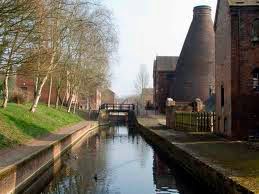
The Ironbridge Gorge as it is known today is midway between Wolverhampton and Shrewsbury. This is the area that was at the forefront of the Industrial Revolution. In 1834 the Coalbrookdale Company built the gothic warehouse, which is now called the Severn Warehouse. This is now the Museum of the Gorge.
As you enter the museum, there is an intricate model of the Gorge as it was in 1796 which was known then as Coalbrookdale. It depicts the location of the industries developed as well as the sources of raw materials of coal, iron, clay and limestone and the River Severn as the source of water for power.
There are many illustrations showing the mines, ironworks, bricks and tile works and other associated manufacturing industries, as well as the revolutionary ‘Hay Inclined Plane’ designed to transport canal boats between the different levels of canals.
A short informative film shows the 10 museums which now occupy the sites along the valley, some of which are working museums. The film gives an overview of the diversity of products that used to be made in the Gorge.
The most visible survivor is the Ironbridge. Little is known about the actual construction of the bridge. It was designed by an architect from Shrewsbury, Thomas Farnholls Pritchard (1723-77). Pritchard did not live to see the bridge completed. Construction began in late 1777 and in 1778 the foundationsTrust and stone abutments were built. The cast iron ribs were erected across the river in 1779. Abraham Darby III was responsible for the construction, but it is not known in which foundry the bridge was cast and how Darby secured the necessary quantity of iron.
The Jackfield Tile Museum Audrey Hooson
The village of Jackfield was once the centre of the world tile making industry. Many famous companies were situated there, or close by, exploiting the excellent clay supply, availability of fuel and long range transport. ‘Broseley’ roofing tiles were made on a large scale. In the 1890’s when production was at its height, it is estimated that that the ‘Broseley’ district produced three-quarters of a million tiles each week. Decorative wall and floor tiles of various types were made by Maw & Co., the Hargreaves, Craven Dunnill Co. Ltd., (later just Craven Dunnill) and many smaller concerns.
The Iron Bridge Gorge Museum Trust bought the remains of Craven Dunnill’s 1874 factory in 1983 and started a project of restoration and development that was finally completed in 2007. The site now contains the unique tile museum, education workshops and facilities for tenant manufacturers and designers. It also has the remaining bases of two large kilns that show the extent of the originals.
The entrance to the museum has a mosaic floor and tiled staircase, leading to a restoration of the original Trade Showroom, Board Room and offices. Panels of different tiles have been fitted to the walls and an original tile cabinet, from Maw & Co’s showroom, installed. Upstairs was the Drawing Office or Design Studio, a high-ceilinged room with two huge Gothic windows to provide maximum light. Until WWI there were Artist and Design classes at the ‘Coalbrookdale Literary and Scientific Institution’. Students were able to enter competitions run by the ‘South Kensington School of Art’ (later part of the V & A). In 1870 Hargreaves, Craven Dunnill Co. Ltd. set up a profit-sharing scheme for all employees; from July to December 1870 it provided a bonus of 5%. Unfortunately the scheme had to be abandoned in the 1930’s, due to the trade recession.
The tiles displayed in the museum are not solely from the Jackfield area. The themes in this room were Style versus Subject Matter, The Aesthetic Movement, Persian and Moorish Designs and Gothic Revival Encaustic Tiles. There were sets of ‘Story Tiles’ showing nursery rhymes, Aesop’s fables and The Seasons. The original examples from William De Morgan and Morris & Company made it obvious that both Maw & Company and Craven Dunnill copied and adapted their designs.
The main section of the museum contained an impressive series of room sets. These use rescued or replicated tiles to show how ubiquitous their use was during the Victorian Era and later. Displayed were Covent Garden Underground station, with Maw’s tiles, a butcher’s shop with a panel of cows and sheep in a meadow and a frieze of vegetative swags and roundels containing pig’s heads. Tiles from the museum collection created an imitation Church of England memorial chapel using encaustic tiles from several locations.
Between the 1890’s and 1930’s many children’s wards in hospitals were decorated with tile panels. By the 1960’s and 70’s these colourful scenes had gone out of fashion. Fortunately many were saved by
the museum. The examples on display, ‘The Maypole’ and ‘ All the Fun of the Fair’, designed by Haydn Jensen, were removed from the Bernard Baron children’s ward at the Middlesex Hospital, London in 1988.
The final room explained the manufacturing technicalities of various floor and wall tiles. With diagrams, videos and material samples for the body of the tile, colouring and decoration. There was also a mould store from the Maw & Co., & Craven Dunnill Collection. These can still be used for replacement and restoration projects.
In London examples from this area can be seen in the V & A, the Marianne North Gallery at Kew, The Royal Academy, Harrods food hall and many churches.
Coalport China Museum Liz Gapp
Having visited the Jackfield Tile Museum, we arrived at the Coalport China Museum, located in works established in the 1790s and closed in 1926, when all work was transferred to Stoke. The entrance is via the shop, which leads straight in to a large display of china dating from the 18th century onwards. A very unusual part of the display shows the evolution of teacup shapes from 1795 to 1925, using half cup relief profiles, with recordings that can be listened to on headphones to explain this.
From here we went to the Demonstration Workshop, where there are a series of techniques on show, starting with the way in which clay is used to throw pots. These are known as ‘jigger’, used to produce flatware (e.g. plates), and ‘jolly’, used to produce hollowware (e.g. cups). The proportions of ingredients used for Coalport’s standard bone china recipe were shown in three glass jars, viz 50% animal bone, 25% Cornish stone, 25% china clay from Cornwall.
The next part of the display here shows the use of moulds and slip casting (used for casting enclosed hollow shapes like teapots), followed by the moulds used for flower making (in clay). Then displayed is the traditional underglaze technique, which was usually in a single colour, alongside modern on- glaze technique, which were multi-coloured. Transfer printing and glaze dipping were also shown.
Several of us were able to talk to a knowledgeable lady who was doing onglaze decoration. She explained that the colours for underglaze decoration were more muted, and there were fewer of them. Also they changed colour with firing, so required some knowledgeable imagination when applying them. They were more durable than the onglaze decoration which, being applied over the glaze, meant they were not dishwasher-proof. However, the onglaze colours were more varied and brighter. She also explained the varying firing temperatures; 800 C, used for glazing transfer prints, up to 1200 C, used for bone china and saggars. The higher the temperature, the more durable the end product, but if the glaze was fired to the higher temperature it would melt the transfer underneath. Saggars have to be strong as they are the containers that contain the unfired ceramics when they are put in the kilns for firing, and are used repeatedly. Also explained was that the length of firing was due to the need to raise the temperature gradually to that required so as not to stress the materials used and cause them to break.
We then moved on to another building, an original bottle oven kiln that had been set up with a cut away mock-up of the way in which the kiln would have been organised for a firing, showing the arrangement of the saggars with the ceramics in them. There is an audio-visual display with a mock-up of the firing, with roaring noise from the fire and flames. Also shown are the access points where sample pots would have been retrieved to test whether they were fired sufficiently or not.
There were several other buildings including a workshop where individual ceramicists work, a saggar makers’ workshop, and another old bottle oven kiln building with a wonderful, well labelled, set of
display cases in the middle. In another area of the building there is a collection of Caughley pottery which concentrated on blue and white pottery and dates from 1750 until around 1799.
This was a fascinating visit, which left plenty to see for a future visit, after which some people went on to visit the Tar Tunnel, whilst the rest of us returned to Ironbridge.
The Tar Tunnel Stewart Wild
After our visit to the Coalport China Museum, a lot of us walked along the canal towpath to the bottom of the Hay Inclined Plane and the adjacent road bridge. Managing to resist for a moment the attractions of a tearoom and ice-cream parlour, we descended some steps, entered what appeared to be the house next door and found ourselves in the entrance to the extraordinary Tar Tunnel. A nice lady checked that we had tickets and gave us hard hats – another piece of ‘elf & safety’ regulations introduced since my last visit!
It all goes back to 1787, the beginning of the Industrial Revolution, when mining in the area was in its heyday. The plan was to connect the canal alongside the River Severn to the lower galleries of the coal mines below Blists Hill, where there is now a lovely open-air museum that we would visit on our final day.
Miners blasted and lined with brick a horizontal tunnel straight into the hill, proceeding for around 3,000ft. As they did so, they noticed naturally occurring bitumen oozing from a layer of sandstone through the walls. Further in, they encountered a gushing spring of the black stuff, which effectively brought digging to an end and turned the owners’ attention to the commercial possibilities of bitumen production.
Ships at the time were made of wood and large quantities of bitumen were needed to caulk the wooden decks and tar the ropes for weatherproofing. Smaller amounts were apparently also bottled and sold as a remedy for rheumatism and other ailments. It is not recorded how profitable the enterprise was, but demand would have dropped as ships were increasingly made of iron and engines replaced sails
Visitors today can walk about 300ft into the tunnel until they reach an iron gate; only tall people are likely to bang their heads. Small amounts of oozing bitumen are clearly visible on the walls. A couple of old coal trucks stand rusting on one side and the tunnel is electrically lit. Display boards at the entrance explain some of the history; there’s nothing like it anywhere else in Britain.
After the failure of the tunnel as a method of bringing coal direct to the canal boats, engineers constructed an inclined-plane railway nearby – basically a pair of railway tracks up the hillside at an angle of around thirty-five degrees. But more of that later as on our last day, we were able to see the tracks from the top of the hill.
The China Museum’s bottle kiln adjacent to the canal
Another view of the impressive 4-story high bottle kiln
Covent Garden Tube Station as many of us remember it – transported to the Tile Museum
Site Watching by HADAS at St John the Baptist churchyard, Chipping Barnet in 2012
Bill Bass & Don Cooper
During the period March to June 2012 work was undertaken to landscape and remodel the churchyard environment. The work was instigated by Barnet Council and carried out by contractors – Blakedown Landscapes (SE) Ltd.
Location
The church is located in the London Borough of Barnet at OS grid ref TQ24514/96476. The
churchyard is west of St John the Baptist church, bounded by High Street (A1000) to the north and Wood Street (A411) to the south. Church Passage runs north to south on the western boundary of the site. A benchmark on the church is at 129.57m od. The archaeological site code is CPA12.
Background
In 1199, the Abbot of St Albans obtained a charter from King John to establish a market at Barnet.
Excavations from Barnet High Street (to the south of the church) and west along Wood Street have recovered pottery and occupation from the mid-12th century. A church was on the site by approx 1250; this was rebuilt in the mid-15th century, with an extensive rebuild in the 1872-1875 period.
Some of the area to the west of Church Passage was owned by bricklayers in the 1700s and by the 1800s shops were being developed in Church Passage especially near the High Street. The Hyde Institute was built along the Passage in 1904.
The Works
It was thought that the present churchyard layout had become a bit untidy and tired, needing a revamp with better accessibility. The recent work included the removal of the boundary “Holly bush Hedge” which aligned with what was iron-paling fencing set in stone setts (the iron fencing probably removed during the war). These stone setts were also removed. Groundworks were dug for the foundations of new hard-standing, steps, benches and paths. Also reworked was the paving surrounding the War Memorial.
Site Watching and Archaeology
Members of HADAS attended the site several times a week during the March to June period of the
works. The main objective was site-watching the boundary hedge removal, the groundworks, which were mainly confined to a narrow trench approx 0.30m wide x 0.40m deep along the side of Church Passage, with more superficial work for the foundation of new paths across the site and adjacent flowerbeds. The spoilheaps from various earthworks were also checked. As the churchyard is still consecrated ground the collection of human bone disturbed by the works was seen as a priority.
As the churchyard has been much remodelled and landscaped in the past, e.g. gravestones moved, a new western church entrance created, the War Memorial moved at some point from the east end of the church to the churchyard, this meant that no features were noted, thus all the finds were treated as being from a single topsoil context.
Finds
HUMAN BONE
71 pieces of bone were collected from across the churchyard, all were disarticulated being re-deposited and scattered over the site. However, most came from the middle section of the site adjacent to the Memorial Garden and along the western hedge line. Susan Trackman produced a report ‘Human Bone Report on disarticulated bones found in 2012’. The report details the bone types found from various parts of the skeleton including skull, mandible, humerus, ulna, ribs, vertebra, femur, fibula, tibia and metacarpals. The fragmentary and random nature of the small sample made it very difficult to ascertain any meaningful results for age, diet, lifestyle, occupation, sex, stature, disease etc. The mandible displayed signs of disease: ” … this woman suffered from severe dental disease – all right mandibular teeth were lost well before death. Remodelling of the bone over the tooth sockets is almost complete”.. Despite the difficulties, the report contains detailed measurement and assessment of all the human bone found. The full report lies with the archive.
ANIMAL BONE
5 pieces of unidentified animal bone were found, 3 jaw teeth, 1 rib, 1 shaft/joint.
POTTERY
119 sherds were recovered consisting of:
Medieval
SHER 1170-1300 x 1
Post- med
BORDY 1550-1700 x 2
PMBL 1580-1700 x 1
PMR 1580-1900 x 14
RBOR 1550-1900 x 4
PMFR 1580-1900 x 4
CHPO 1580-1900 x 1
STSL 1660-1870 x 2
ENGS 1700-1900 x 10
TPW 1780-1900 x 73
TGW SPNG 1780-1900 x 2
MOCH 1780-1900 x 5
CLAY PIPE
1 x Mouth piece 60 x Stems
Pipe bowls
Decorations
1 x AO21 1680-1710, Spur marks: Decoration
1 x AO28 1700-1770, Spur marks: Decoration: –
3 x AO27 1780-1820, Spur marks: Sun Decoration: Wheatsheaf
3 x AO28 1820-1860, Spur marks: KS WT Decoration: Oaks/Leaves
1 x AO29 1840-1880, Spur marks: Decoration Wheatsheaf
7 x AO30 1850-1910, Spur marks: Decoration: Wheatsheaf
1 x AO31 1850-1910, Spur marks: R Decoration: –
7 x AO33 Post 1840, Spur marks: WT TTY, Sun Decoration: Oaks/Leaves
1 x Calabash Early 20th C, Decoration: White metal rim
2 x Unknown
COINS
1854 Napoleon III, 10 Centimes, worn
1860 George III, ½ Penny, very worn/degraded 1971 2p
1985 2p
1994 2p
2005 2p
CBM
5 x sherds of peg tile
1 x fragment of roof slate
1 x sherd of inscribed sherd of decorated chimney pot
1 x sample brick (railing stone foundation) 280mm long, 120mm wide, 50mm deep, very shallow frog.
GLASS
13 x bottle glass, 1 x complete small bottle, 2 x window glass
METAL
1 x coffin handle, 1 x knife blade, 2 x shoe sole reinforcements, 4 x nails (all metal heavily corroded).
Conclusion
The pottery broadly dates from the late 16th century to late 19th century and consists mainly of the common post-medieval wares e.g. Borderwares (BORDY), Mochawares (MOCH), Redwares (PMR), English stonewares (ENGS) and Transfer Printed Wares (TPW), consisting mostly of plates, cups and bowls. One sherd of medieval pottery was noted.
The clay-pipe dates from the late 17th century to early 20th century some with spur-marks and decoration. So far the spur-marks have not been matched with makers from the London region, but as Barnet was a major coaching stop the pipes could have come from a wide ranging area. One fragment of the AO33 type bowls was partially stamped HIGH……. which may be ‘Highgate’ an area in north London known to have had clay pipe manufacturers.
The finds are essentially random samples from an unstratified context, they were found in the groundworks or the spoilheaps associated with the work adjacent to Church Passage. They would represent casual loss e.g. coins & clay-pipe, along Church Passage, a busy thoroughfare today as it would have been years ago. The pottery, glass, building materials etc would represent domestic rubbish dumping in the area with some of the iron items from coffin furniture.
Acknowledgments
Ben Garrett, Adrian Barnden and James Fitzgerald for Blakedown Landscapes (SE) Ltd.
Megan Hallett & Caroline Bragg for Barnet Council
St John the Baptist: Church Warden Nigel Baker and Rector Canon Hall Speers Sue Trackman for the bone report.
Kim Stabler, English Heritage.
English Heritage At Risk Register Jim Nelhams
English Heritage (EH) maintains a list of areas and structures that it considers to be “at risk”. The EH website states: “The Heritage at Risk programme provides a dynamic picture of the health of England’s built heritage. It also provides advice on how best to save those sites most at risk of being lost forever.”
English Heritage is committed to reducing the overall number of sites at risk of loss as a result of neglect, decay and inappropriate development. How this will be achieved is set out in the Heritage at Risk Strategy.
Every year EH publishes a list of those sites most at risk of being lost. The latest list was published in October and includes the following within the London Borough of Barnet. At this time, the list does not include Church Farmhouse – something we need to keep under review.
The items/areas currently listed are: Brockley Hill site
College Farm, Finchley including the main building, dairy and silo.
At Avenue House, The Bothy and the concrete Water Tower. Two tombs in the churchyard at St Mary’s Hendon.
The monument to Major John Cartwright at St Mary’s Finchley. The Physic Well in Barnet.
Colindale Hospital administrative block.
With limited resources, English Heritage can not easily monitor all listed items but rely on knowledgeable observers, such as HADAS members, to warn them if things deteriorate.
Other Societies’ Events Eric Morgan
Sunday 25th November to Monday 3rd December. Barnet Borough Arts Council. The Spires (Outside Waitrose) Barnet. Paintings and Drawings & What’s On info (incl. HADAS).
Saturday 1st December, 11 a.m. to 1 p.m. Museum of London: George Peabody – East End to the City. Walk through 150 years of his history, from the earliest estate to the seat of his financial successes and his statue next to the Royal Exchange. Cost £10 (concs. £8, Friends £7). Book online at www.museumoflondon.org.uk/events or call 020 7001 9844. (HADAS’s October lecture was on George Peabody.)
Sunday 2nd December, 10:30 a.m. Heath and Hampstead Society. The Hidden Heath. Meet at the Gazebo near the old kitchen garden, east of Kenwood House, Hampstead Lane, N6.
Walk led by Michael Hammerson (Highgate Society), archaeologist & HADAS member. Cost £3.
Sunday 2nd December, from noon. Barnet High Street Christmas Fair. Music, dance, stalls in the High Street, theatre in The Bull, crafts fairs in Church House and exhibitions at Barnet Museum.
Tuesday 4th December, 6:30 p.m. LAMAS – Clore Learning Centre, Museum of London, 150 London Wall, EC2Y 5HN. “There is nothing like dissecting to give you an appetite” – doctors and nurses in Dickens. Kevin Brown. £2. (Refreshments at 6:00)
Thursday 6th December, 7:30 p.m. London Canal Museum, New Wharf Road, Kings Cross, N1 9RT. “The Chesterfield Canal, Past, Present and Future.” Geraint Coles. £4 (concs. £2.50).
Thursday 6th December, 8:00 p.m. Pinner Local History Society. Village Hall, Chapel Lane, Pinner. “George Arliss, our first Oscar winner?” Talk by Barbara Lanning. Visitors, £2.
Other Societies’ Events (continued)
Monday 10th December, 7:45 p.m. West Wessex Archaeology Group (WEAG). School Hall, Woodford County High School, High Road, Woodford Green, IG8 9LA. “Domestic Finance in Roman
Britain”. Talk by Amelia Dowler.
Wednesday 12th December, 2:30 – 4:00 p.m. Mill Hill Historical Society, Trinity Church, The Broadway, Mill Hill, NW7. “Elstree – Britain’s Hollywood”. Talk by Bob Redman.
Tuesday 11th December, 2 – 3 p.m. Harrow Museum, Headstone Manor, Pinner View, North Harrow, HA2 6PX. “Dicken’s Christmas”. Talk by Colin Oakes. £2.
Tuesday 11th December, 7:45 p.m. Amateur Geological Society, The Parlour, St Margaret’s Church, Victoria Avenue, Finchley, N3 1BD. “A Burgess Shale type Biota from the Cambrian of Australia”. Talk by Dr Greg Edgecombe (Natural History Museum).
Wednesday 12th December, 7:45 p.m. Hornsey Historical Society, Union Church Hall, corner of Ferme Park Road/Weston Park, N8 9PX. “The History of Lord’s Cricket Ground.” Talk by Stephen Green. Visitors £2. Refreshments.
Thursday 13th December, 7:30 p.m. Camden History Society. Burgh House, New End Square, NW3 1LT. “Celebrating Christmas in Medieval London.” Talk by Caroline Barron. £1. Wine and mince pies from 7:00 p.m.
Friday 14th December 2:00 – 2:30 p.m. and 3:00 – 3:30 p.m. Museum of London, EC2Y 5HN. “Roman Fort Visit.” Tour of the remains of the Western Gate of London’s military fort, located beneath the streets next to the Museum. Free, but tickets allocated on arrival.
Friday 21st December, 12:00 – 2:00 p.m. Museum of London (as above). “Archaeology Close Up”. Drop in on monthly object handling sessions with members of the Museum’s Archaeological Collections Department. Free.
